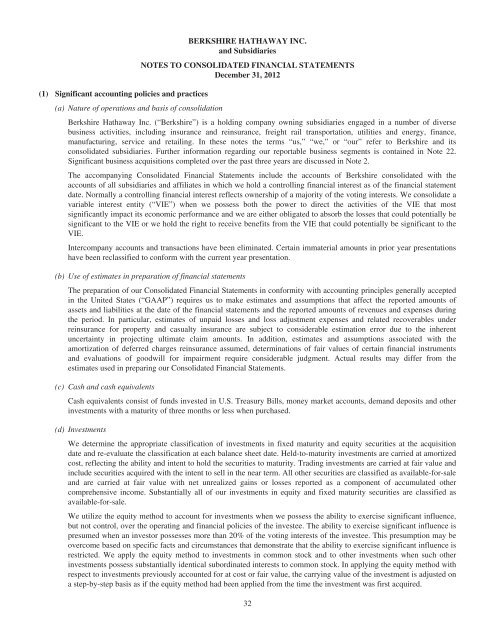BERKSHIRE HATHAWAY
BERKSHIRE HATHAWAY
BERKSHIRE HATHAWAY
Create successful ePaper yourself
Turn your PDF publications into a flip-book with our unique Google optimized e-Paper software.
(1) Significant accounting policies and practices<br />
(a) Nature of operations and basis of consolidation<br />
<strong>BERKSHIRE</strong> <strong>HATHAWAY</strong> INC.<br />
and Subsidiaries<br />
NOTES TO CONSOLIDATED FINANCIAL STATEMENTS<br />
December 31, 2012<br />
Berkshire Hathaway Inc. (“Berkshire”) is a holding company owning subsidiaries engaged in a number of diverse<br />
business activities, including insurance and reinsurance, freight rail transportation, utilities and energy, finance,<br />
manufacturing, service and retailing. In these notes the terms “us,” “we,” or “our” refer to Berkshire and its<br />
consolidated subsidiaries. Further information regarding our reportable business segments is contained in Note 22.<br />
Significant business acquisitions completed over the past three years are discussed in Note 2.<br />
The accompanying Consolidated Financial Statements include the accounts of Berkshire consolidated with the<br />
accounts of all subsidiaries and affiliates in which we hold a controlling financial interest as of the financial statement<br />
date. Normally a controlling financial interest reflects ownership of a majority of the voting interests. We consolidate a<br />
variable interest entity (“VIE”) when we possess both the power to direct the activities of the VIE that most<br />
significantly impact its economic performance and we are either obligated to absorb the losses that could potentially be<br />
significant to the VIE or we hold the right to receive benefits from the VIE that could potentially be significant to the<br />
VIE.<br />
Intercompany accounts and transactions have been eliminated. Certain immaterial amounts in prior year presentations<br />
have been reclassified to conform with the current year presentation.<br />
(b) Use of estimates in preparation of financial statements<br />
The preparation of our Consolidated Financial Statements in conformity with accounting principles generally accepted<br />
in the United States (“GAAP”) requires us to make estimates and assumptions that affect the reported amounts of<br />
assets and liabilities at the date of the financial statements and the reported amounts of revenues and expenses during<br />
the period. In particular, estimates of unpaid losses and loss adjustment expenses and related recoverables under<br />
reinsurance for property and casualty insurance are subject to considerable estimation error due to the inherent<br />
uncertainty in projecting ultimate claim amounts. In addition, estimates and assumptions associated with the<br />
amortization of deferred charges reinsurance assumed, determinations of fair values of certain financial instruments<br />
and evaluations of goodwill for impairment require considerable judgment. Actual results may differ from the<br />
estimates used in preparing our Consolidated Financial Statements.<br />
(c) Cash and cash equivalents<br />
Cash equivalents consist of funds invested in U.S. Treasury Bills, money market accounts, demand deposits and other<br />
investments with a maturity of three months or less when purchased.<br />
(d) Investments<br />
We determine the appropriate classification of investments in fixed maturity and equity securities at the acquisition<br />
date and re-evaluate the classification at each balance sheet date. Held-to-maturity investments are carried at amortized<br />
cost, reflecting the ability and intent to hold the securities to maturity. Trading investments are carried at fair value and<br />
include securities acquired with the intent to sell in the near term. All other securities are classified as available-for-sale<br />
and are carried at fair value with net unrealized gains or losses reported as a component of accumulated other<br />
comprehensive income. Substantially all of our investments in equity and fixed maturity securities are classified as<br />
available-for-sale.<br />
We utilize the equity method to account for investments when we possess the ability to exercise significant influence,<br />
but not control, over the operating and financial policies of the investee. The ability to exercise significant influence is<br />
presumed when an investor possesses more than 20% of the voting interests of the investee. This presumption may be<br />
overcome based on specific facts and circumstances that demonstrate that the ability to exercise significant influence is<br />
restricted. We apply the equity method to investments in common stock and to other investments when such other<br />
investments possess substantially identical subordinated interests to common stock. In applying the equity method with<br />
respect to investments previously accounted for at cost or fair value, the carrying value of the investment is adjusted on<br />
a step-by-step basis as if the equity method had been applied from the time the investment was first acquired.<br />
32


